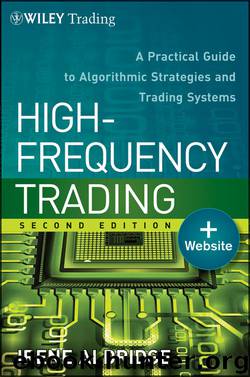High-Frequency Trading by Irene Aldridge

Author:Irene Aldridge
Language: eng
Format: epub
ISBN: 9781118416822
Publisher: Wiley
Published: 2013-03-27T16:00:00+00:00
Equity Markets
A typical trading day is filled with macroeconomic announcements, both domestic and foreign. How do the macroeconomic news impact equity markets?
According to classical financial theory, changes in equity prices are due to two factors: changes in expected earnings of publicly traded firms, and changes in the discount rates associated with those firms. Expected earnings may be affected by changes in market conditions. For example, increasing consumer confidence and consumer spending are likely to boost retail sales, uplifting earnings prospects for retail outfits. Rising labor costs, however, may signal tough business conditions and decrease earnings expectations as a result.
The discount rate in classical finance is, at its bare minimum, determined by the level of the risk-free rate and the idiosyncratic riskiness of a particular equity share. The risk-free rate pertinent to U.S. equities is often proxied by the three-month bill issued by the U.S. Treasury; the risk-free rate significant to equities in another country is taken as the short-term target interest rate announced by that country's central bank. The lower the risk-free rate, the lower is the discount rate of equity earnings and the higher are the theoretical prices of equities.
How does macroeconomic news affect equities in practice? Ample empirical evidence shows that equity prices respond strongly to interest rate announcements and, in a less pronounced manner, to other macroeconomic news. Decreases in both long-term and short-term interest rates indeed positively affect monthly stock returns with 90 percent statistical confidence for long-term rates and 99 percent confidence for short-term rates. (See Cutler, Poterba, and Summers,1989, for example.) Anecdotal evidence suggests that most adjustments of prices occur within seconds or minutes of the announcement time.
Stock reaction to nonmonetary macroeconomic news is usually mixed. Positive inflation shocks tend to induce lower stock returns independent of other market conditions (see Pearce and Roley, 1983, 1985, for details). Several other macroeconomic variables produce reactions conditional on the contemporary state of the business cycle. Higher-than-expected industrial production figures are good news for the stock market during recessions but bad news during periods of high economic activity, according to McQueen and Roley (1993).
Similarly, unexpected changes in unemployment statistics were found to cause reactions dependent on the state of the economy. For example, Orphanides (1992) finds that returns increase when unemployment rises, but only during economic expansions. During economic contractions, returns drop following news of rising unemployment. Orphanides (1992) attributes the asymmetric response of equities to the overheating hypothesis: when the economy is overheated, increase in unemployment actually presents good news. The findings have been confirmed by Boyd, Hu, and Jagannathan (2005). The asymmetric response to macroeconomic news is not limited to the U.S. markets. Löflund and Nummelin (1997), for instance, observe the asymmetric response to surprises in industrial production figures in the Finnish equity market; they found that higher-than-expected production growth bolsters stocks in sluggish states of the economy.
Whether or not macroeconomic announcements move stock prices, the announcements are always usually surrounded by increases in market volatility. While Schwert (1989) pointed out that stock market volatility
Download
This site does not store any files on its server. We only index and link to content provided by other sites. Please contact the content providers to delete copyright contents if any and email us, we'll remove relevant links or contents immediately.
Bad Blood by John Carreyrou(6552)
Rich Dad Poor Dad by Robert T. Kiyosaki(6401)
Principles: Life and Work by Ray Dalio(6208)
Playing to Win_ How Strategy Really Works by A.G. Lafley & Roger L. Martin(5916)
Management Strategies for the Cloud Revolution: How Cloud Computing Is Transforming Business and Why You Can't Afford to Be Left Behind by Charles Babcock(4525)
The Confidence Code by Katty Kay(4187)
Thinking in Bets by Annie Duke(4152)
American Kingpin by Nick Bilton(3755)
Delivering Happiness by Tony Hsieh(3365)
Project Animal Farm: An Accidental Journey into the Secret World of Farming and the Truth About Our Food by Sonia Faruqi(3177)
The Power of Habit by Charles Duhigg(3059)
The Tyranny of Metrics by Jerry Z. Muller(3000)
Brotopia by Emily Chang(3000)
Mastering Bitcoin: Programming the Open Blockchain by Andreas M. Antonopoulos(2981)
The Marketing Plan Handbook: Develop Big-Picture Marketing Plans for Pennies on the Dollar by Robert W. Bly(2975)
I Live in the Future & Here's How It Works by Nick Bilton(2935)
The Content Trap by Bharat Anand(2860)
Building a StoryBrand by Donald Miller(2841)
Applied Empathy by Michael Ventura(2838)
